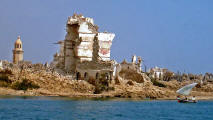|
|
 |
| SUDAN - Suakin |
|
|
 |
| SUDAN - Suakin |
 |
Mohammed, one of the local "agents" dressed in white robes, came onboard with all the papers to check us in - although the total costs for check-in, anchorage fee, agent's fee, etc. was NOT cheap. |
 |
|
| We relaxed onboard reveling in the wondrous sight onshore. After the buildings of the city, built of coral blocks held together with a minimum amount of mortar and wooden beams, were abandoned, they quickly fell into disrepair. |
 |
 |
In 2003 all buildings, which need constant maintenance, had collapsed although some were still inhabited as recently as the 1960's. Now the site is home to numerous camels that roam the shoreline. |
 |
| Suakin also
has earned the dubious notoriety of being the last slave
trading centre in the world – a role apparently held until
as recently as the1960s. The township which still exists, is a rather ramshackle, dusty place and its inhabitants clearly extremely poor. |
|
We bought fresh flat-pancake type bread off a cart |
Water is transported by donkey cart |
Ramshackle shanties, sticks and burlap |
The ever present Mosque wails its Call to Prayer |
Port Sudan March 20 We took a local bus to Port Sudan to find some groceries and a market. The bus does not leave until it is completely full, which includes jump seats pulled down to fill the isle, so once your in, your crammed amongst the locals. On one side of me an Arab, head wrapped loosely in a rag, polished his huge elaborately carved sword with the side of a coin; on the other side a women mostly covered, with a baby on her lap, was adorned with large rings thru her nose, on her fingers and even on her toes! Her hands were henna tattooed all over. |
| In the middle of nowhere the bus
would stop and someone would get off. All around were miles of sand
and nothingness. Port Sudan was a haven for picture taking but that is forbidden. Whenever our cameras came out someone would approach and say "no photos" and the police threatened to take Becky's camera away! A man on the bus told us that Americans relate to CIA so they must think we are all spies! The streets were full of donkeys and goats and more goats, chewing on the produce for sale at the market. Fresh goat and chickens were strung up and even bloody Angora goat hides were offered for sale. We bought a few fresh veggies but there are no supermarkets as such so I will have to make do with the dwindling provisions on board. All the shops sold the same things, which put bargaining skills to the challenge. |
March 21 We sailed out of the lagoon in Suakin at 5 am as the rising sun was casting a yellow glow on the ruins, past pink flamingos wading in the nearby shallow water. We decided to only sail as far as Port Sudan because that would make our next destination the following day easier. We were concerned that we may have check in problems at Port Sudan but when we informed the officials that we would not be getting off the boat and leaving early the following day, there was no problem. Port Sudan was an industrial port with ships coming and going at all times of the day and night, sometimes getting too close for comfort as we were anchored quite close to the dock. |
|
We went ashore
determined to climb Quoin Hill at the head of the inlet. Although
the hill is only 59 meters high, it has a very rugged outline with
two summits. The climb over the crumbly, sharp corally rock in the
intense heat was difficult but we managed to reach the summit. |
 |
||
 |
The views
from the top were worth the climb. You could see the reef formations
in the turquoise colored Marsa, with its ribbon like entrance and
our boats safely anchored in the lagoon. The surrounds were
sculptured mountains displaying an array of desert colours.
|
||
NEXT EGYPT >>>>> |